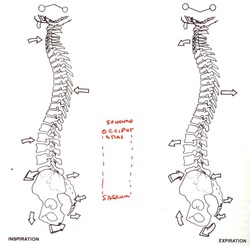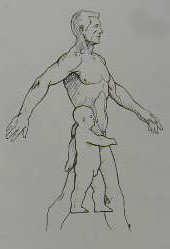I will try to once again describe the connective tissue, or Fascia system, and how that would be involved. This system starts on the underside of the top of the skull bones, wraps around the brain, and moves in a three dimensional pattern all the way down through the toes. This system also carries with it the energy dimension that we discussed in previous articles as it has a dense system of nerve endings that sense our ever changing environment. The tissue is not feed by the blood system of the body but by a thick syrupy fluid (interstitial fluid or cellular fluid) that gives it much of its integrity. This tissue also permits the movement of the body to transpire as it is the material that stretches and takes form. Tissue is what surrounds all of the other components, including organs, of the internal anatomy of the body; It also keeps us from ripping our skin as movement takes place as every other component of the anatomy is able to slide over each other during movement.
As you can see the Fascia plays an integral part of the body's ability to move. When we injure ourselves many changes take place within the body and multiple distortions accure. This creates the change of Tensegrity within, and this is what the Muscle Release Therapy, MRTh(r) practitioner looks for and changes. We find the imbalanced tension in the muscular structure but it is the Fascia that tells the story. When we find the imbalance and position the muscle so a response is able to take place the individual will experience an internal movement. The wavy movement is the Fascia, and as that begins the restructuring of the ligaments are able to start their process of repositioning and stabilizing so that movement of the skeleton can begin.
You may ask how does working on the foot affect the neck? As my mentor, the late Dr. Tom Maday, would often tell me "Where it is, it ain't". The foot is a very complex piece of mechanical equipment, but it is this Fascia system that connects the body. Because of its makeup and the fact that it is a continuous material from head to toe, any alteration to it affects the integrity and tension. When the body experiences trauma its entire entity is affected; for example when we stumble the entire body works to keep us upright and also helps to protect the brain and spinal cord. This creates what I refer to as the onion effect- - many layers that need to be peeled back to reach the internal core.
In the case of the foot, we have talked about the ability to absorb shock, maintain balance, and create a mechanical apparatus to help us walk. It also provides a source of structural support that the body uses to reduce pressure and allow various movements to take place; because of nerve messages that are sent from the magnitude of ligaments that help position and stabilize the 26 bones that make up the anatomy of the foot itself. In other words, if you came in complaining of a stiff neck and I just treated that, the stiff neck more often than not, would return. Why?! Because of the distortion of the connective tissue, and the relationship with the other structures that it is comprised of. It truly is a case of the old song that stated the knee bone was connected to the hip bone.
Next to the Tail bone (Sacrum), and the Pelvis the foot has the most ligaments; meaning that there is a greater probability of movement in the foot than almost anywhere else in the body. Going back to our ancestral days when footwear was not so fashionable, going bare foot, and having calloused feet was much more prevalent. The ligaments were not so confined and were able to better serve their mission. It is often this restriction of movement that creates complications to patterns and responses to sudden changes in our surroundings. For example, if we are walking on a sidewalk and there is a slight change in elevation from one slab to the next, our feet are not as perceptible of the change and can cause us to lose our balance and either twist our ankle or knee, and compress our hip and tail bone joint.
What really happens is a compound trauma as the body needs to accommodate all of the changes that have taken place. As stated the Fascia system, being a continuous network of fiber, has to change all of the positioning of the internal structure that it protects. Once this has taken place it will hold this position until there is some force of physical change, hopefully a therapeutic one. If you were to take a nylon stocking and stretch it out and place a small slit in it, you would have an erratic change in its makeup. This is what happens to the Fascia. You might scrap or give yourself a paper cut, well the same result happens, erratic movement takes place. Something small you think but over time will develop into a chronic condition.
Myofasical Release as performed at our office by Tanya Weiker, LPT or Muscle Release Therapy, MRTh(R) addresses this scenario. It locates and allows the Fascia to reconstruct itself to a "normal" or natural balance. The major difference in the two therapies is in MRTh(R) the ligaments re-position the skeleton. Often times though in long term chronic pain it would probably benefit the individual to have the Fascia re-structured along with the Muscle Release Therapy, MRTh(R) to ensure long term benefits. In the long run it would be worth the personal investment as much internal stress would be relieved. If you have questions, please contact our office at 216-364-0152 or [email protected].
Next week we will go into further discussion of movement and how improper foot movement will cause the spine to react and often cause low back pain. Till next week, remember......
there is a Reason to HOPE!
Dennis


 RSS Feed
RSS Feed
